Driving in Spain: The questions most learners get wrong on their theory test

Getting your driving licence in Spain can be challenging, especially if you are a foreigner who isn’t quite fluent in Spanish yet. To help you out, here are the 10 questions most people got wrong in their theory test in Spain throughout 2023.
There are two parts to the driving test in Spain – the practical and the theoretical. The theoretical test consists of 30 questions. In order to pass, you can’t get more than three answers wrong.
According to data from Spain's General Directorate of Traffic (DGT), 64 percent of applicants pass the theoretical exam, of which 71 percent pass it on the first try.
PONS Road Safety, who work with more than 1,300 driving schools has listed the ten most failed questions in the theory test after analysing more than two million online tests carried out by thousands of future drivers during 2023. Here are the 10 most common:
READ ALSO - Driving in Spain: Can I take my theory and practical tests in English?
1. ¿Cuál es la sanción por utilizar, sujetando con la mano, el teléfono móvil mientras se encuentra en un semáforo en rojo?

Can you use your phone when stopped at a red light? Photo: D'Vaughn Bell / Pexels
A. Pérdida de 6 puntos y €500.
B. Pérdida de 6 puntos y €200.
C. Pérdida de 3 puntos y €200.
(Translation) What is the penalty for using a mobile phone while stopped at a red light?
A. Loss of 6 points and €500.
B. Loss of 6 points and €200. (Correct answer)
C. Loss of 3 points and €200.
Explanation: Using a mobile phone device while driving and holding it in your hand is considered a serious offense and entails the loss of 6 points and a fine of €200.
2. Cuando llueve o poco después de haber llovido, ¿qué debe hacer antes del cruce o adelantamiento, especialmente si se trata de vehículos voluminosos o pesados?
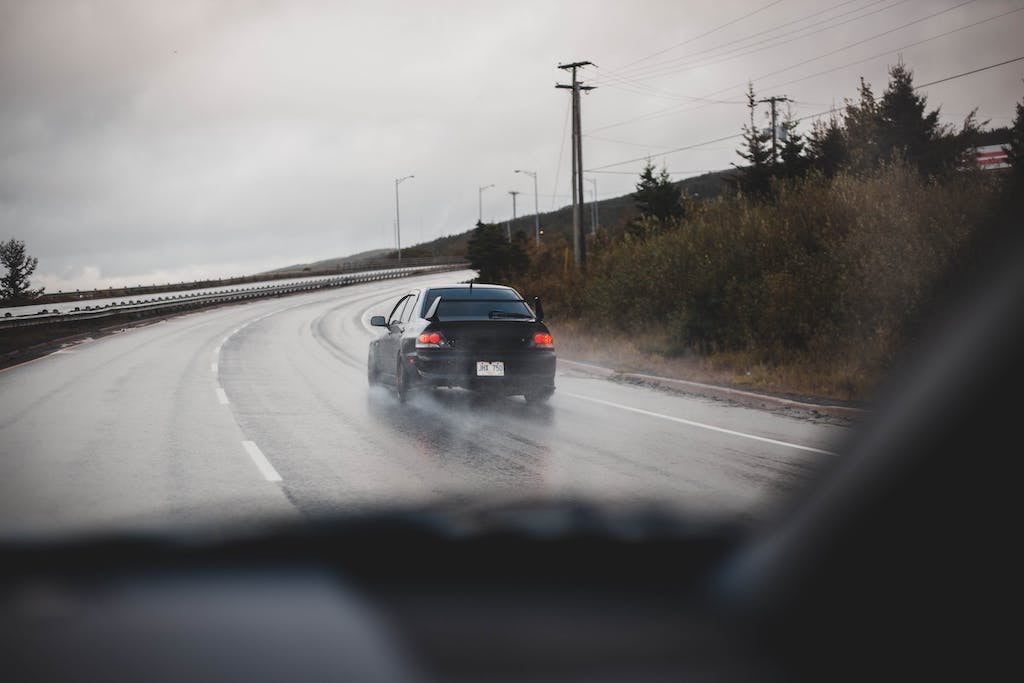
Driving in the rain. Photo: Erik Mclean / Pexels
A. Disminuir la velocidad, accionando el freno de estacionamiento
B. Poner en funcionamiento el limpiaparabrisas a la velocidad más rápida.
C. Advertirlo mediante destellos o señales acústicas.
(Translation) When it rains or shortly after it has rained, what should you do before crossing or overtaking, especially if you are dealing with bulky or heavy vehicles?
A. Reduce speed by applying the parking brake.
B. Operate the windshield wipers at the fastest speed. (Correct answer)
C. Warn it by flashing lights or beeping horn.
Explanation: When you come across another vehicle, especially if it is a big vehicle, and there is water on the road, water will splash on your windshield, therefore, it is advisable to activate the windshield wipers.
3. Señal de prohibición de giro a la izquierda y de cambio de sentido
Esta señal prohíbe...
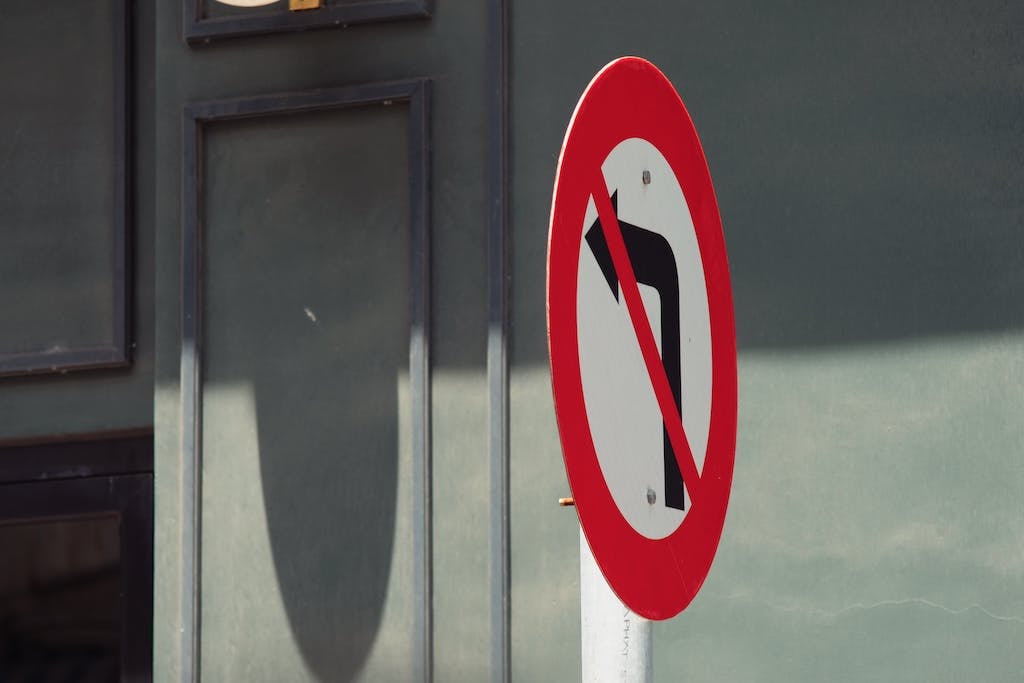
What does this sign indicate in Spain? Photo: Nguyen Huy / Pexels
A. Girar a la derecha, únicamente.
B. Girar a la izquierda, únicamente.
C. Girar a la izquierda y cambiar el sentido de la marcha.
(Translation) This sign prohibits...
A. Turn right only.
B. Turn left only.
C. Turn left and change in direction of travel. (Correct answer)
Explanation: This is the sign R-303 that prohibits turning left. It also prohibits changing the direction of travel.
4. En caso de avería en esta vía, ¿cómo debe colocar los triángulos de preseñalización de peligro?
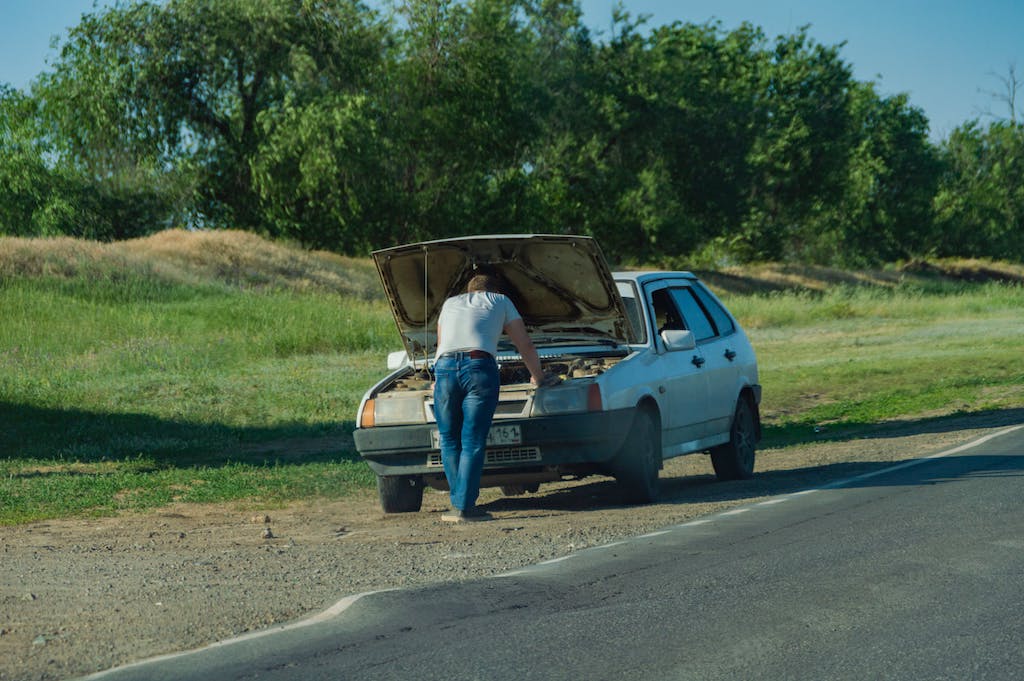
What must you do if you break down on the side of the road? Photo: Paul H / Pexels
A. Dos triángulos, a 100 metros de distancia.
B. Dos triángulos, uno por delante y otro por detrás del vehículo, a 50 metros.
C. No estoy obligado a colocarlos.
(Translation) In the event of a breakdown, how should you place the danger warning triangles?
A. Two triangles, 100 metres apart.
B. Two triangles, one in front and one behind the vehicle, 50 meters away.
C. I am not obliged to place them. (Correct answer)
Explanation: Although you must signal that the vehicle is damaged until January 1st, 2026, it is not mandatory to place the aforementioned triangles after the vehicle is immobilised due to an accident or breakdown.
5. Señal de circulación para automóviles, excepto motocicletas. ¿Puede circular cualquier vehículo por una calzada con esta señalización?
A. No, porque es una vía exclusiva para automóviles.
B. Sí.
C. Sí, excepto motocicletas de dos ruedas sin sidecar.
(Translation) Can any vehicle circulate on a road that has this sign?
A. No, because it is exclusively for cars.
B. Yes. (Correct answer)
C. Yes, except for two-wheeled motorcycles without a sidecar.
6. En esta curva sin visibilidad, ¿está permitido adelantar?
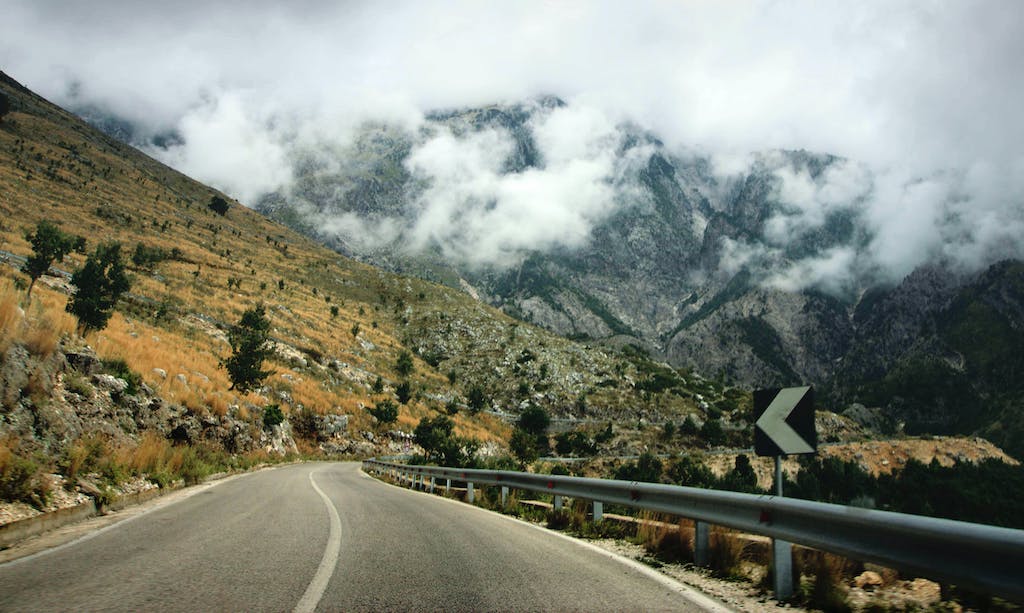
Is it permitted to overtake on a blind curve in Spain? Photo: Pexels
A. No, en ningún caso.
B. Sí, pero solo para vehículos de dos ruedas.
C. Sí, sin invadir el sentido contrario.
(Translation) On a blind curve, is overtaking allowed?
A. No, not in any situation.
B. Yes, but only for two-wheeled vehicles. (Correct answer)
C. Yes, without getting in the way of cars going in the opposite direction.
Explanation: Overtaking is prohibited on curves and grade changes with reduced visibility.
7. Un turismo que lleva el distintivo medioambiental que aparece en la imagen, clasificado como '0' emisiones, ¿está autorizado a circular por el carril habilitado para vehículos de alta ocupación (VAO)?
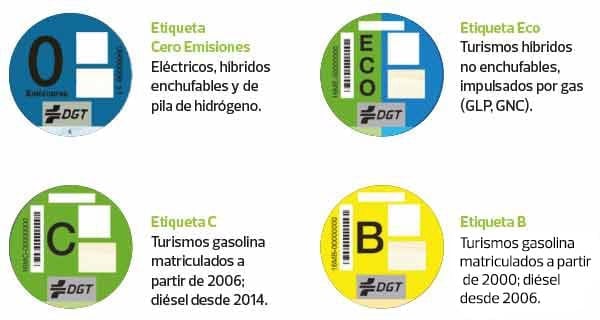
Low-emissions stickers. Source: DGT
A. Sí, aunque vaya solo el conductor.
B. No, salvo que por los paneles de mensaje variable se autorice su acceso.
C. Sí, siempre que esté ocupado por al menos dos personas, incluido el conductor.
(Translation) Is a car that bears the environmental badge that appears in the image, classified as '0' emissions, authorised to circulate in the lane enabled for high occupancy vehicles (HOV)?
A. Yes, even if the driver is alone. (Correct answer)
B. No, unless access is authorised through the variable message panels.
C. Yes, as long as it is occupied by at least two people, including the driver.
Explanation: The use of the HOV-enabled lane is limited to motorcycles, passenger cars and adaptive mixed vehicles, which are occupied by at least two people, including the driver. The HOV lane may also be used by these other vehicles.
8. Hay nueva normativa para regular los Vehículos de Movilidad Personal. Los patinetes no pueden circular por las aceras. ¿Puede circular por vías interurbanas un vehículo de movilidad personal VMP?
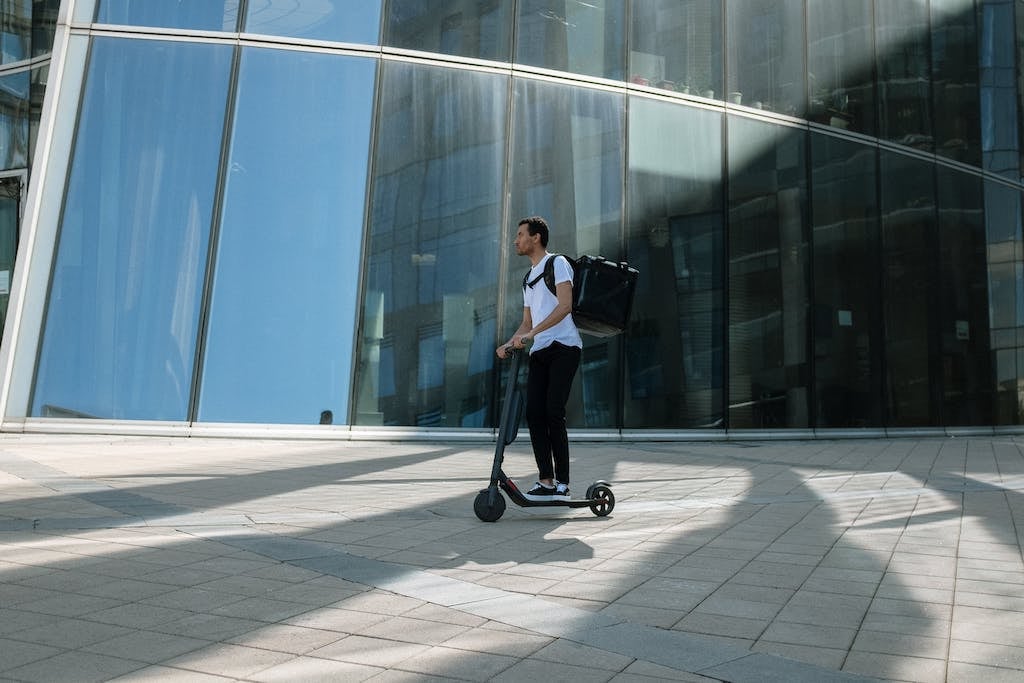
Where are electric scooters allowed to go? Photo: cottonbro studio / Pexels
A. Sí, si lo hace por el arcén.
B. No, debe circular solo por vías urbanas y travesías.
C. No.
(Translation) There are new regulations to regulate Personal Mobility Vehicles. Scooters cannot travel on sidewalks. Can a personal mobility vehicle (PMV) travel on interurban roads?
A. Yes, if you do it on the shoulder.
B. No, you must circulate only on urban roads and crossroads.
C. No. (Correct answer)
9. ¿Cómo se debe circular en una pendiente ascendente con nieve?

What should you do when driving uphill in snow? Photo: Adrien Olichon / Pexels
A. Con una relación de marchas cortas.
B. Con una relación de marchas lo más alta posible.
C. Lentamente y reteniendo el vehículo.
(Translation) How should you drive on an upward slope with snow?
A. With a short gear ratio.
B. With the highest possible gear ratio.
C. Slowly and holding the vehicle.
Explanation: When there's snow grip decreases, so you should drive slowly, increase the distance from the vehicle in front, use a gear ratio that is as high as possible, but at the same time be compatible with safety rules. You should also make sure you have the correct tires and that the brakes are in good condition.
10. ¿Se permite hacer uso de ráfagas con el alumbrado de largo alcance para advertir al vehículo que le precede la intención de adelantar?

Overtaking other vehicles. Photo: Lukas Rychvalsky / Pexels
A. No.
B. Sí, pero únicamente fuera de poblado.
C. Sí, tanto en poblado como fuera de poblado.
(Translation) Is it permitted to use high-range lighting flashes to warn the vehicle in front of the intention to overtake?
A. No
B. Yes, but only outside the town.
C. Yes, both in the town and outside the town. (Correct answer)
Explanation: It is permitted both inside and outside the town to warn that you're going to overtake and avoid a possible accident.
Comments
See Also
There are two parts to the driving test in Spain – the practical and the theoretical. The theoretical test consists of 30 questions. In order to pass, you can’t get more than three answers wrong.
According to data from Spain's General Directorate of Traffic (DGT), 64 percent of applicants pass the theoretical exam, of which 71 percent pass it on the first try.
PONS Road Safety, who work with more than 1,300 driving schools has listed the ten most failed questions in the theory test after analysing more than two million online tests carried out by thousands of future drivers during 2023. Here are the 10 most common:
READ ALSO - Driving in Spain: Can I take my theory and practical tests in English?
1. ¿Cuál es la sanción por utilizar, sujetando con la mano, el teléfono móvil mientras se encuentra en un semáforo en rojo?

A. Pérdida de 6 puntos y €500.
B. Pérdida de 6 puntos y €200.
C. Pérdida de 3 puntos y €200.
(Translation) What is the penalty for using a mobile phone while stopped at a red light?
A. Loss of 6 points and €500.
B. Loss of 6 points and €200. (Correct answer)
C. Loss of 3 points and €200.
Explanation: Using a mobile phone device while driving and holding it in your hand is considered a serious offense and entails the loss of 6 points and a fine of €200.
2. Cuando llueve o poco después de haber llovido, ¿qué debe hacer antes del cruce o adelantamiento, especialmente si se trata de vehículos voluminosos o pesados?

A. Disminuir la velocidad, accionando el freno de estacionamiento
B. Poner en funcionamiento el limpiaparabrisas a la velocidad más rápida.
C. Advertirlo mediante destellos o señales acústicas.
(Translation) When it rains or shortly after it has rained, what should you do before crossing or overtaking, especially if you are dealing with bulky or heavy vehicles?
A. Reduce speed by applying the parking brake.
B. Operate the windshield wipers at the fastest speed. (Correct answer)
C. Warn it by flashing lights or beeping horn.
Explanation: When you come across another vehicle, especially if it is a big vehicle, and there is water on the road, water will splash on your windshield, therefore, it is advisable to activate the windshield wipers.
3. Señal de prohibición de giro a la izquierda y de cambio de sentido
Esta señal prohíbe...

A. Girar a la derecha, únicamente.
B. Girar a la izquierda, únicamente.
C. Girar a la izquierda y cambiar el sentido de la marcha.
(Translation) This sign prohibits...
A. Turn right only.
B. Turn left only.
C. Turn left and change in direction of travel. (Correct answer)
Explanation: This is the sign R-303 that prohibits turning left. It also prohibits changing the direction of travel.
4. En caso de avería en esta vía, ¿cómo debe colocar los triángulos de preseñalización de peligro?

A. Dos triángulos, a 100 metros de distancia.
B. Dos triángulos, uno por delante y otro por detrás del vehículo, a 50 metros.
C. No estoy obligado a colocarlos.
(Translation) In the event of a breakdown, how should you place the danger warning triangles?
A. Two triangles, 100 metres apart.
B. Two triangles, one in front and one behind the vehicle, 50 meters away.
C. I am not obliged to place them. (Correct answer)
Explanation: Although you must signal that the vehicle is damaged until January 1st, 2026, it is not mandatory to place the aforementioned triangles after the vehicle is immobilised due to an accident or breakdown.
5. Señal de circulación para automóviles, excepto motocicletas. ¿Puede circular cualquier vehículo por una calzada con esta señalización?
A. No, porque es una vía exclusiva para automóviles.
B. Sí.
C. Sí, excepto motocicletas de dos ruedas sin sidecar.
(Translation) Can any vehicle circulate on a road that has this sign?
A. No, because it is exclusively for cars.
B. Yes. (Correct answer)
C. Yes, except for two-wheeled motorcycles without a sidecar.
6. En esta curva sin visibilidad, ¿está permitido adelantar?

A. No, en ningún caso.
B. Sí, pero solo para vehículos de dos ruedas.
C. Sí, sin invadir el sentido contrario.
(Translation) On a blind curve, is overtaking allowed?
A. No, not in any situation.
B. Yes, but only for two-wheeled vehicles. (Correct answer)
C. Yes, without getting in the way of cars going in the opposite direction.
Explanation: Overtaking is prohibited on curves and grade changes with reduced visibility.
7. Un turismo que lleva el distintivo medioambiental que aparece en la imagen, clasificado como '0' emisiones, ¿está autorizado a circular por el carril habilitado para vehículos de alta ocupación (VAO)?

A. Sí, aunque vaya solo el conductor.
B. No, salvo que por los paneles de mensaje variable se autorice su acceso.
C. Sí, siempre que esté ocupado por al menos dos personas, incluido el conductor.
(Translation) Is a car that bears the environmental badge that appears in the image, classified as '0' emissions, authorised to circulate in the lane enabled for high occupancy vehicles (HOV)?
A. Yes, even if the driver is alone. (Correct answer)
B. No, unless access is authorised through the variable message panels.
C. Yes, as long as it is occupied by at least two people, including the driver.
Explanation: The use of the HOV-enabled lane is limited to motorcycles, passenger cars and adaptive mixed vehicles, which are occupied by at least two people, including the driver. The HOV lane may also be used by these other vehicles.
8. Hay nueva normativa para regular los Vehículos de Movilidad Personal. Los patinetes no pueden circular por las aceras. ¿Puede circular por vías interurbanas un vehículo de movilidad personal VMP?

A. Sí, si lo hace por el arcén.
B. No, debe circular solo por vías urbanas y travesías.
C. No.
(Translation) There are new regulations to regulate Personal Mobility Vehicles. Scooters cannot travel on sidewalks. Can a personal mobility vehicle (PMV) travel on interurban roads?
A. Yes, if you do it on the shoulder.
B. No, you must circulate only on urban roads and crossroads.
C. No. (Correct answer)
9. ¿Cómo se debe circular en una pendiente ascendente con nieve?

A. Con una relación de marchas cortas.
B. Con una relación de marchas lo más alta posible.
C. Lentamente y reteniendo el vehículo.
(Translation) How should you drive on an upward slope with snow?
A. With a short gear ratio.
B. With the highest possible gear ratio.
C. Slowly and holding the vehicle.
Explanation: When there's snow grip decreases, so you should drive slowly, increase the distance from the vehicle in front, use a gear ratio that is as high as possible, but at the same time be compatible with safety rules. You should also make sure you have the correct tires and that the brakes are in good condition.
10. ¿Se permite hacer uso de ráfagas con el alumbrado de largo alcance para advertir al vehículo que le precede la intención de adelantar?

A. No.
B. Sí, pero únicamente fuera de poblado.
C. Sí, tanto en poblado como fuera de poblado.
(Translation) Is it permitted to use high-range lighting flashes to warn the vehicle in front of the intention to overtake?
A. No
B. Yes, but only outside the town.
C. Yes, both in the town and outside the town. (Correct answer)
Explanation: It is permitted both inside and outside the town to warn that you're going to overtake and avoid a possible accident.
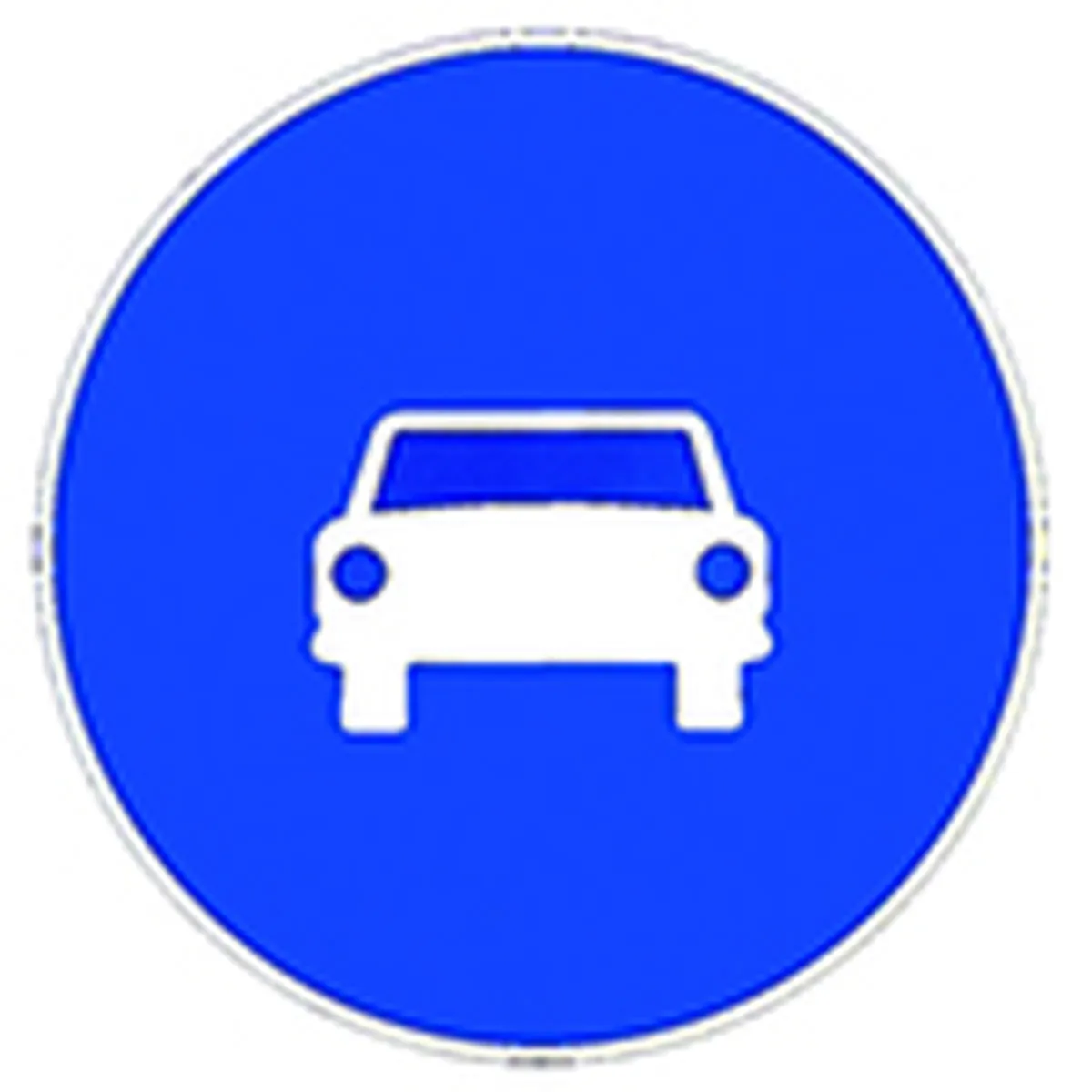
Join the conversation in our comments section below. Share your own views and experience and if you have a question or suggestion for our journalists then email us at [email protected].
Please keep comments civil, constructive and on topic – and make sure to read our terms of use before getting involved.
Please log in here to leave a comment.